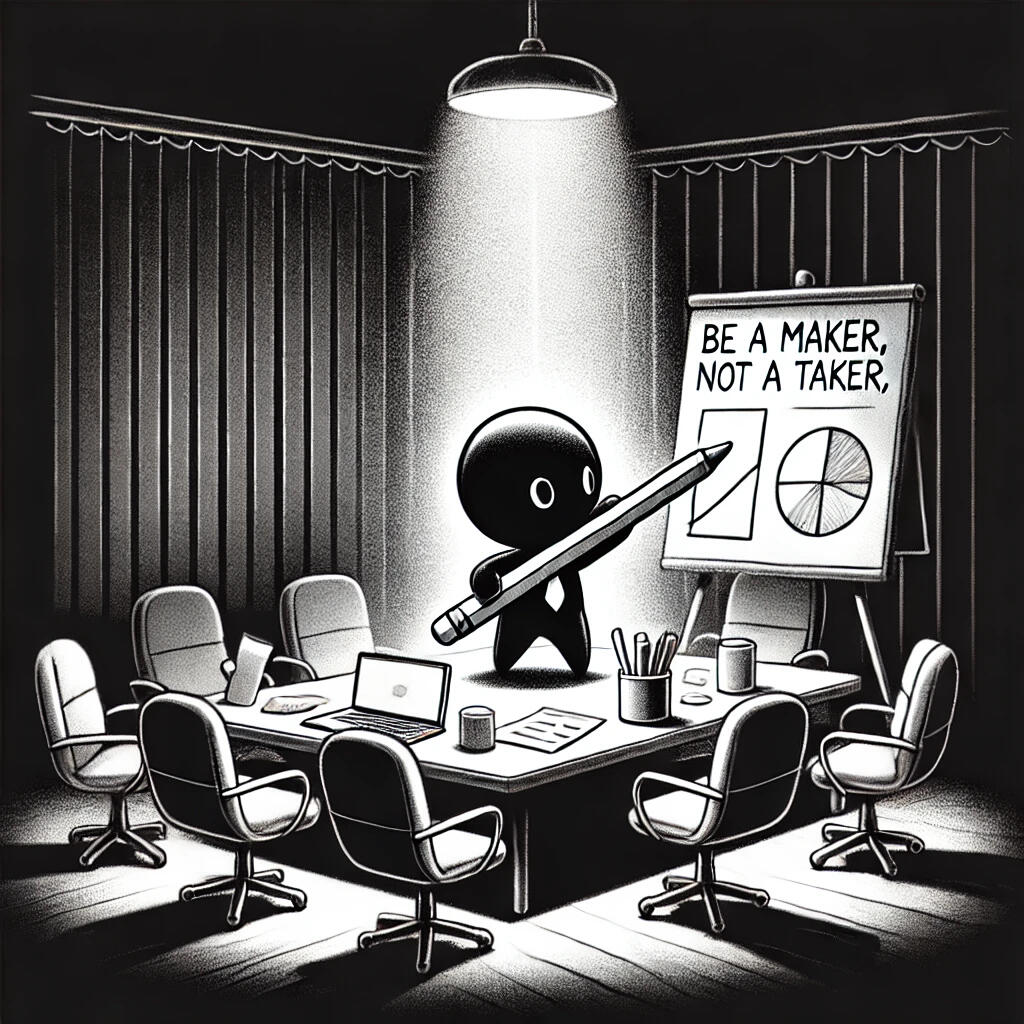THE CHEATCODES ON HOW TO
ACE YOUR JOB, BABY
Ace your job
Write an internal newsletter
Leverage internal newsletters to build connections and influence within your company by sharing insights, personal stories, and valuable content.Internal newsletters are a powerful way to connect with and influence. Instead of trying to reach everyone, invite only the most interesting and influential people in the organization & make them feel exclusive. Shaan Puri created a personalized newsletter at Twitch, inspired by James Clear’s format, to engage top executives. He shared a mix of personal stories, thoughts, and useful links, creating a unique and relatable connection. This approach not only built relationships but also positioned him as a thoughtful and engaged team member, making a lasting impact within the company.


Ace your job
Be a maker. Not taker.
Be a maker, not a taker—create your own plans and presentations to sharpen your skills and position yourself as a leader.To become a leader, don’t just consume others’ work—be the one creating it. Steph Smith exemplified this by taking ownership of creating Google Sheets and Google Slides, therefore controlling the flow of information in her projects, making her indispensable. The key is to be proactive: write your own plans, craft proposals, and share your updates. Don’t wait for a promotion to start acting like a leader. Do the work now, make your contributions visible, and you’ll position yourself as a key player in any organization. If you want to lead, start doing the things leaders do—create, present, and make your contributions visible. This proactive approach will help you get recognized and eventually promoted.
Ace your job
Work in public
Be visible—regularly showcase your work to ensure it’s recognized, balancing humility with the need to stand out.In a big company, it's crucial to make your work visible. Being "loud" doesn’t mean boasting, but rather ensuring that others know about the valuable work you're doing. Regularly share your progress, including both successes and lessons from mistakes. Many people, especially women, struggle with this, but it’s essential because if your contributions aren’t seen, they might as well not exist. Take time to highlight your work and achievements, balancing transparency with the need to be recognized for your efforts.


Ace your job
5% impact projects
Only work on projects that move the needle—focus on efforts that can make at least a 5% impact on the company.When Shaan Puri's team at Twitch felt unmotivated after being acquired, they realized the project they were assigned wouldn’t significantly impact the company’s key metrics. This led to the adoption of the "5% Rule": only work on projects that can move the needle by at least 5%. By setting this standard, you ensure that your work is meaningful and impactful. Just as valuing your time increases productivity, focusing on high-impact projects elevates your contributions and solidifies your role as a key player in the organization.
Ace your job
Look good on Zoom
Invest in your video call setup—looking and sounding great on calls can set you apart and make your ideas more impactful.A simple way to stand out at work is by upgrading your video setup. Use an iPhone with the Camo app for DSLR-quality video, add a $50 light, and invest in a decent microphone like a Blue Yeti or Shure. This minimal investment puts you in the top 1% in terms of presentation. No matter how great your ideas are, if they’re delivered poorly, they’ll be less effective. Think of it as the digital equivalent of dressing well—it’s a small change that makes a big difference.


Ace your job
McKinsey Pyramid
Confidence and clarity in communication are key—lead with conclusions and support them with clear reasoning for maximum impact.In corporate communication, many people make the mistake of burying the lead, following a beginning-middle-end structure. However, busy executives prefer the opposite approach. The McKinsey Pyramid Principle flips this by starting with the main recommendation or conclusion, followed by supporting arguments. This method ensures your key point is clear from the start, making your communication more effective and easier for decision-makers to process. Stack your arguments like a pyramid, leading with the most critical information, and you'll communicate with greater clarity and impact.
Ace your job
What? Why?
So what?
Use the "What, Why, So What" framework for clear communication—structure your message to make it concise and impactful.To become a more effective communicator, use the "What, Why, So What" framework. Start by explaining what happened (or what will happen), then clarify why it happened (or why it’s planned), and finally, address the "so what"—the implications or next steps. This simple structure ensures your message is clear and actionable. By bullet-pointing these sections before writing, you’ll find that 80-90% of your material is already organized, making your communication more concise and effective, whether in emails, reports, or presentations.


Ace your job
Probablity vs. certainty
Confidence and clarity in communication are key—lead with conclusions and support them with clear reasoning for maximum impact.Confidence doesn’t mean claiming certainty. The best leaders think in probabilities, not absolutes. When making a recommendation, include your confidence level—whether it’s 70% or even 30%. This honesty helps manage expectations and shows strategic thinking. If there’s a lower chance of success, explain the potential upside and how the risks are mitigated. This approach builds trust and positions you as a thoughtful decision-maker, capable of assessing both risks and rewards. It’s not just about being right; it’s about being transparent and strategic.
Ace your job
Beat your own estimates
Underpromise and overdeliver—set realistic expectations, then exceed them to build trust and leave room for positive surprises.In business, it’s better to underpromise and overdeliver. Shaan shared a lesson from his dad, who once adjusted a presentation from claiming 100 times better results to just three times better. The clients were thrilled with the modest claim, leaving room for an even greater impact later. This approach avoids the risk of disappointing by failing to meet overly ambitious promises. Instead, by setting realistic expectations and then exceeding them, you build trust and credibility, which are crucial for long-term success.


Ace your job
Assumption breaking questions
Confidence is about asking intelligent questions that challenge assumptions and break through conventional thinking.True confidence isn’t about always having the right answer; it’s about asking the right questions. Great leaders stand out by asking intelligent questions that challenge assumptions, break conventional thinking, and cut to the core of a problem. Instead of confidently choosing between two bad options, ask, "What’s the simple solution we’re missing?" or "How have others solved this?" These questions can lead to better outcomes and demonstrate a deeper, more thoughtful confidence that resonates in any meeting or discussion.
Ace your job
Five interesting people
Build your future team today—identify and nurture relationships with top talent in your current company for future opportunities.If you’re working at a company but have dreams of starting your own, start building your future team now. Create your own "Midas list" by identifying the five most talented and interesting people you'd want to recruit later. While you're there, focus on gaining valuable leadership insights, earning the CEO's respect, and connecting with potential future hires. This strategy not only prepares you for your next venture but also ensures you leave with a strong network of top talent ready to join you when the time comes.


Ace your job
Fix papercut wounds
Identify and fix "paper cut" problems—small, overlooked issues that, once resolved, significantly boost your visibility and impact.One of the quickest ways to make an impact in a new job is to find and fix "paper cut" problems—those small, persistent annoyances that everyone tolerates but nobody addresses. By solving these minor issues, you not only improve the work environment but also significantly boost your stock within the company. It’s about going beyond your job description and tackling something that others have overlooked, which makes you stand out. Small efforts like this can lead to big rewards, showing that you’re proactive, attentive, and ready to take initiative.
Ace your job
Work on A+PLUS PROBLEMS
Focus on the "A+ problem"—the most critical issue facing your company. Prioritize it over routine tasks to make a real impact.In any company, there’s always an "A+ problem"—the critical issue that keeps the executive team up at night. To truly stand out, identify this problem and focus your efforts on solving it, even if it means putting your routine tasks on hold. By tackling the biggest challenges, you align yourself with the highest-impact work and position yourself as a key contributor. This approach not only enhances your visibility but also connects you with the top talent in the company, making you indispensable.


Ace your job
Asking for a promotion
Pitch your promotion as a business solution—show how it addresses a company need, not just your personal career goal.When asking for a promotion, shift the focus from “I want this title” to “the company needs this role.” Identify pain points—like gaps in leadership or stretched teams—and position yourself as the fix. Demonstrate how your skills, relationships, and past wins make you the right person to solve these problems. This approach reframes your promotion as a strategic advantage for the business, not just a reward for individual effort. That’s how decision-makers listen.
FRAMEWORKS WORK.
BUT ONLY IF YOU
PUT IN THE WORK.
I'm Gaurabh Mathure - a keen actioner & listener of the MFM Pod. I love frameworks and wanted a way to reference them myself and share it with others. I appreciate you checking it out. I hope you learned something from this to put into action.In the meantime, tell me what you think, share your feedback.
JUST F* IT!
The next time you’re stuck, don’t just wing it. Just framework it.Whether it’s deciding on your next career move, figuring out how to tell a story, or just navigating daily life, a solid framework is like having a personal GPS—it gets you where you want to go faster, with less stress.But here’s the kicker: the real power of frameworks is in their ability to help you think clearly, cut through the noise, and focus on what truly matters._LIKE HOW THIS SITE LOOKS?
If you like this site and want to create something similar, you can buy this template.
*Content is inspired by frameworks shared on the MFM podcast. Illustrations created by me with a little help from my AI friends.